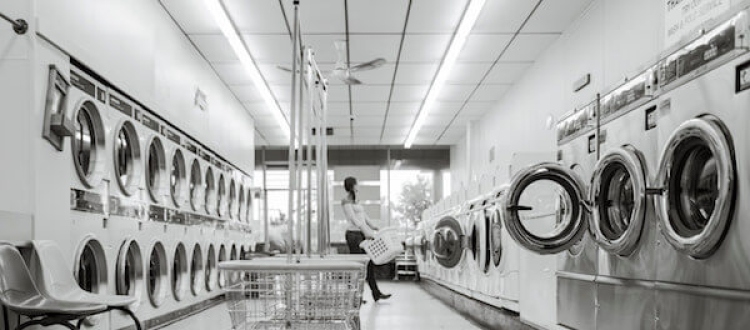
Cleaning linen the old-fashioned way: Urine, sour milk and elbow grease!
If you thought doing laundry was a chore, we've got some fascinating historical facts about how people cared for linen before modern washing machines and Persil made an appearance. Linenbeauty.com met with textile historian and museums officer Emma O'Connor, of Sussex Past, a charity which runs several historic sites in Sussex, England, and learned some pretty eye-opening things about cleaning linen the old-school way. Here's what she told us:

LB: Thanks so much for agreeing to talk to us about how linen was used in the past. Could you tell us a bit about the different uses and how people cared for their linens?
EO'C: Well, you may know the word 'line' comes from the Latin for linen, 'linum', due to the threads in the fabric. Our word 'lining' also has a historical root in the linens that were worn as undergarments to protect outer layers. In the past, going back to the 16th and 17th Centuries, most working class people wore coarse woollen clothing which would never be washed. Instead they would wear linen underwear because the fabric was washable, durable and more comfortable than the itchy wool they wore on top. This would have been perfunctorily washed.
LB: And what about the wealthier sections of society? Was linen used much by them?
EO'C: The nobility and aristocracy did use linens in their big houses, as well as for cuffs and sleeves which could be detached and washed. The grand, stiff silk dresses would not be washed so using interchangeable linen ruffs and collars meant the worst of the dirt around the places with most wear could be removed. Household linens like tablecloths and bedlinen would only be washed once or twice a year, during the 'Great Wash'. You would need a huge amount of room to store all the linens until then, as well as many staff to launder the linens, so this was really a big deal. It required money!
LB: How long would a Great Wash take?
EO'C: At least a week. It's a very lengthy process. There comes a point when it stops being about having clean clothes - the whole process becomes a way of demonstrating wealth and status. The lower classes just didn't have the time or the fuel to heat large coppers. To wash the household linens they were first soaked in urine (men's preferably! [there ensued a rather off-topic discussion of the reasons for this, which we don't need to go into here...]) for a few days, then spots or stains were scrubbed in more urine. The ammonia in the urine acted as a cleaning agent, and it was known as 'night water'. People would go round collecting it!
LB: And then what?
EO'C: Next the linens were put into a 'bucking tub', where they were pounded in lukewarm water. A piece of linen or muslin was stretched over the top of the tub and onto that was put homemade lye (made from fat and ash, and sour milk was added for a brighter colour). Water was poured through this lye over and over again - 8 to 12 times. You can find recipes for lye in books offering women advice on how to keep a good home dating back to the late 16th Century. The linen was then agitated with a washing dolly (a kind of four-legged pogo stick) or board, and then rinsed several times. Finally, it would have been laid outside to dry. Sunlight helped with bleaching them as white as possible. The whiter your linen, the grander you would appear. After several days drying the linens would be ironed, using flat irons heated over a fire and that would need scoring and greasing. Starch was made from potatoes or candle grease.

LB: You can see why so many people were involved! What a huge task. And I thought my piles of daily washing were tedious!
EO'C: Things changed during the 18th Century, when people moved into the towns. There were communal laundries and drying fields, which took some of the work out of it. There was also a growing social pressure on the working classes to be sent o be washing their clothes. We've got a photograph of a very poor family of charcoal cutters living in a shack with nothing, and in the photo you can see a pristine white piece of clothing or linen drying on a line.
LB: More work for the women then.
EO'C: They were very clever with their linens too. From the late 18th Century, in line with mass production, you see more heirloom linens being passed on through families. You can see in wills that linens were bequeathed, and by the late 18th early 19th Century working class homes would often have 'best' linens that would be used on 'high days and holidays'. Any linens that began to wear out were cut and re-sewn: sheets were turned 'top-to-toe' and stitched down the middle, other linens were cut into rags or retrimmed for different uses. The durability is what makes linen such a popular choice, as well as environmentally friendly.
LB: Where would most of these linens that were being used in Britain come from?
EO'C: Ireland and Europe mostly. Places where the climate was right. Dutch linens were popular as they were seen as very fine and very white - possibly due to the geography of the region providing large, flat drying fields. In the late 18th Century we see the birth of mail order, meaning women could get hold of linens that matched their budgets.

LB: Thanks so much Emma, this has been so fascinating.
In fact, it was so interesting that Emma has agreed to get together another time and make a video showing how these old linen cleaning techniques worked, including making our own lye (though we may draw the line at using urine!). We thought we could wash one linen tea towel the modern way, and one the old-fashioned way, and then compare the results. We will keep you posted with news of our cinematic début!
For more on how to clean your linen, go here or here.
(Images above: Lewes castle in Sussex with linens drying amongst ruins, courtesy of Sussex Past; detail of bleaching grounds from painting via http://www.oldandinteresting.com/drying-outdoors.aspx; and painting of Dutch linens drying by Jacob van Ruisdael via learner.org)
